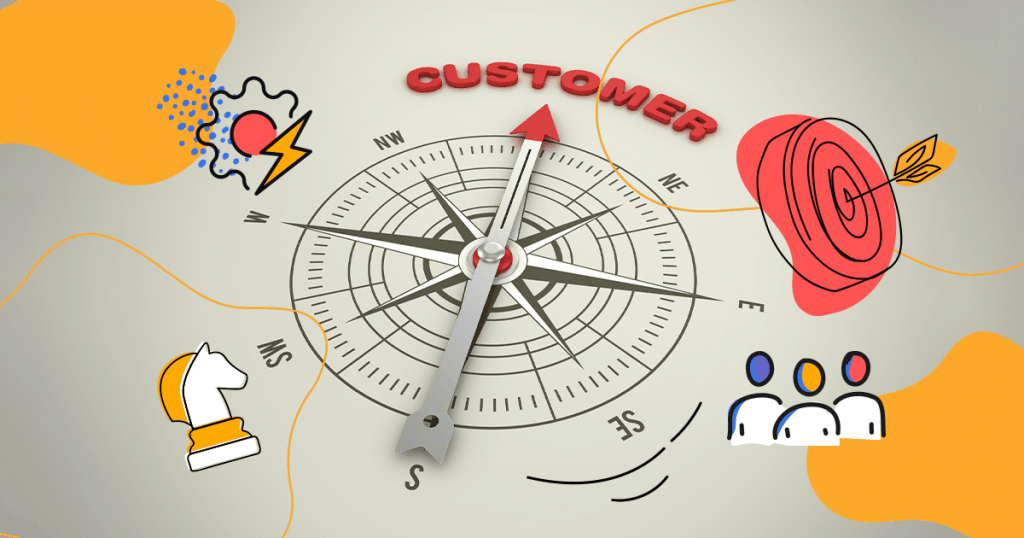You’ve probably said that the customer is always right, or the customer comes first more times than you can count. Every business owner says these things.
However, do you actually focus on these statements in your business strategy?
Honestly, probably not. Most businesses are focused on what they need rather than what their customers need.
This includes reduced costs and more sales.
The thing is that you cannot truly improve your bottom line as much as you’d like if you don’t focus on your customers.
Luckily, you aren’t the only company making this mistake. Many of your competitors are as well. Their digital marketing strategy likely doesn’t contain a forward-thinking approach to the needs of customers.
So, what does this mean for you?
It means you have the chance to get ahead by doing better when it comes to making your customers a priority. The key to all of this is customer orientation, the focus of this blog post.
- What is Customer Orientation?
- Why is it Important to Be Customer-Oriented?
- How to Implement Customer Orientation
- Customer Orientation Examples
- Wrap Up: Are You Ready to Take the Customer-Oriented Approach to Business?
What is Customer Orientation?
Customer orientation can be defined as a specific business approach that can be taken to put the needs of a customer first and foremost, even over the needs of the business itself.
Businesses that are customer-oriented understand that they can’t be successful if they aren’t constantly focusing on customers, their satisfaction, and their needs.
Therefore, all parts of the business, including sales and marketing, should maintain a focus on customer needs.
Basically, being a customer-oriented brand means that you truly realize that your customers make or break your business.
Why is it Important to Be Customer-Oriented?
There are numerous benefits to becoming a customer-oriented business.
Basically, the happier you are able to make your customers, the more likely they will be to remain loyal to your brand and become brand ambassadors.
It has been reported that 57% of customers have stated that customer service is one of the main factors that make them remain loyal to a particular brand.
This is particularly true when their customer service experience resulted in having their issue being resolved quickly.
On the other hand, when customers have to remain on hold for extended periods of time for help, it can result in a terrible customer service experience.
Further, it is far more cost-effective to retain your customers than it is to have to acquire new customers.
In fact, it can cost as much as seven times more to acquire a brand-new customer.
By focusing more on your customers, especially in terms of quality customer service, there is a better chance of holding on to them.
Finally, focusing on your customers just seems to be the right thing to do. The best part of it all is that you can improve your bottom line by becoming customer-oriented.
How to Implement Customer Orientation
In order to put the needs and wants of your customers first, you must understand what they are and who your customers are.
Therefore, you must first identify the needs of your customers, which means researching into buyer persona, needs, and interests. As soon as you do this, you can truly start to implement customer orientation.
Here are a few things you can do to define your overall strategy.
#1: Obtain Customer Feedback
Before you can truly focus on your customers, you must know what they are thinking.
This will allow you to find areas where you need to improve. So, you need to get feedback from your customers, and it is a good idea to do this on a regular basis.
One way to obtain customer feedback is through the use of customer satisfaction surveys.
You can make things as simple or as complex as you’d like with these surveys. The most important thing is to ask if their experience was good or bad and provide them with a comment box where they can leave additional feedback in their own words about their experience.
You can also use Customer Effort Score surveys, which will allow customers to rate the ease of their experience.
Again, leave a comment box for their own words if they have additional feedback to provide.
Regardless of the method you prefer, the main goal is to determine how positive the customer service experience is for your customers and how easy it is for them to have their problems resolved.
#2: Use the Feedback to Set Future Goals
As you examine the feedback that your customers provide, you may be shocked to learn of areas where you are lacking. Now is the time to address those areas with new goals.
For example, if you have a particular agent with low Customer Satisfaction Survey scores, you will want to pay closer attention to their work.
Further, additional training may be a good idea to help them improve in the areas where they are suffering.
If your Customer Effort Score surveys show that customers prefer live chat interactions to email correspondence, you may want to consider reducing response times via email.
While this may not be where your customers are happy, it can improve their satisfaction if they receive a response quicker than usual.
#3: Be Empathetic
In order for you and your team to know how to properly help a customer, you need to be able to empathize with them and the challenges they are facing.
If you can put yourself in their shoes and understand how they’re feeling, you will be able to help them feel better more successfully while also helping them reach a positive solution to their problem.
Being empathetic means using kind, thoughtful dialogue, even when you need to say “no” or let the customer know that you are unable to assist them in their particular situation.
Making a list of certain empathy statements for your team to use with customers can go a long way in improving customer connections.
Don’t forget that empathy is also about asking questions and actively listening.
You must ask questions to identify the problem your customer is facing, as they may be too distraught to truly tell you outright.
At the same time, you must be actively listening to your customers to “hear” what they are saying or not saying.
If employees can learn to use empathy when dealing with customers, regardless of whether it is related to customer service or something else entirely, meaningful relationships can be built with customers who will remain loyal to the brand.
#4: Recruit the Right Individuals
It doesn’t matter what type of customer orientation strategy you have in place if your customer service team is not made up of the right people.
Many businesses hire based on skills, but skills can be taught.
When you are trying to move toward a customer-focused brand, you need to focus on individuals with the right personality and attitudes.
Make sure your team members are empathetic and can solve problems.
Remember, your team can literally make or break the customer service experience your customers have with your brand.
#5: Give Your Customers Something New
Customers know how powerful they are, and they constantly want to immerse themselves in new experiences.
Therefore, that same old promotional speech isn’t going to do the trick any longer. Instead, you need to focus on establishing a relationship with your customers to encourage regular consumption of your content and products.
How do you do this?
One way is to offer your customers something they haven’t yet experienced with your brand, such as interactive content.
Interactive content examples include infographics, quizzes, calculators, videos, and more — all of which can help to create a memorable experience for your customers.
Interactive content is extremely successful, as it is much more appealing than static content. It has been shown to have at least twice as much engagement as regular static content.
Interactive content can also be used to capture quality customer data, improve lead generation, retain your customers, improve overall engagement, and much more.
Customer Orientation Examples
There are plenty of companies that have already implemented the customer orientation approach into their business.
Here is a look at a few of the most successful ones who put their customers first in their business model in case you need some inspiration for your own journey.
#1: Apple
Apple is a company that completely understands the needs of customers and builds specifically for them.
Let’s consider the iPod. While there were other similar products available at the time (standard MP3 players), they could only hold a certain number of songs, such as 30 to 40.
Of course, this was fine with most people who were used to a Walkman.
The first iPod was able to hold 1,000 songs. It was out there, but it was exactly what customers wanted, even though they didn’t realize it. But Apple knew.
To be customer-oriented, you not only need to focus on the needs of your customers, but you also must anticipate those needs before they realize they have them.
#2: Harley Davidson
This is probably a company you expected to see here, but Harley Davidson knows how to get the job done when it comes to prioritizing customers.
It all starts within the job interview process.
Anyone hoping to become a Harley Davidson employee must be able to prove they have the knowledge of Harley Davidson in general as well as how bikes work.
The company only wants to hire people who are familiar with the products they sell, as these individuals will be most likely to be able to connect and emphasize with current and prospective customers.
This creates a memorable and rewarding experience for customers.
#3: Amazon
One thing that sets Amazon apart from its competition is its ability to personalize the experience of each customer.
For example, the product recommendations section of the website utilizes advanced technology to identify customer browsing data based on previous purchases and searches.
This lets customers feel like Amazon knows what they need before they need it.
Wrap Up: Are You Ready to Take the Customer-Oriented Approach to Business?
Don’t assume that you must go through a complete restructuring of your company in order to become customer-oriented.
All you need to do is make a few minor changes here and there so that you and your team are putting customer needs first, above all else.
Although it most certainly will take time and effort to switch to a customer-oriented approach, you can build levels of trust with your customers that otherwise wouldn’t have been possible.
In the end, the more you care about your customers, the more your business will grow.
If you want to really take your business to the next level, check out the Rock Content Magazine featuring everything you need to know about data-driven marketing.









